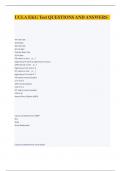Bpm sa node 60 100 bpm - Study guides, Class notes & Summaries
Looking for the best study guides, study notes and summaries about Bpm sa node 60 100 bpm? On this page you'll find 1082 study documents about Bpm sa node 60 100 bpm.
Page 2 out of 1.082 results
Sort by
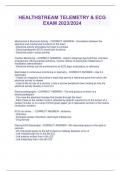
-
HEALTHSTREAM TELEMETRY & ECG EXAM 2023/2024
- Exam (elaborations) • 13 pages • 2023
- Available in package deal
-
- $13.49
- 2x sold
- + learn more
HEALTHSTREAM TELEMETRY & ECG EXAM 2023/2024 Mechanical & Electrical Activity - CORRECT ANSWER-- Correlation between the electrical and mechanical functions of the heart - Electrical activity stimulates the heart to contract - Electrocardiogram (ECG) show both functions - Electrical pulse= action potntial Cardiac Monitoring - CORRECT ANSWER-- Used to diagnose dysrhythmias, chamber enlargement, MI/myocardial ischemia, monitor effects of electrolyte imbalances of medication administrat...
QUESTIONS AND ANSWERS
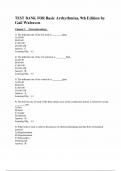
-
TEST BANK FOR Basic Arrhythmias, 9th Edition by Gail Walraven, Answered
- Exam (elaborations) • 33 pages • 2024
-
- $12.64
- + learn more
TEST BANK FOR Basic Arrhythmias, 9th Edition by Gail Walraven, Answered-1) The inherent rate of the SA node is bpm. A) 30-60 B) 40-60 C) 60-100 D) 100-120 Answer: C Learning Obj.: 1.3 2) The inherent rate of the AV junction is bpm. A) 20-40 B) 40-60 C) 60-100 D) 100-120 Answer: B Learning Obj.: 1.3 3) The inherent rate of the ventricle is bpm. A) 20-40 B) 40-60 C) 60-100 D) 100-120 Answer: A Learning Obj.: 1.3 4) The built-in rate of each of the three major areas of the cond...
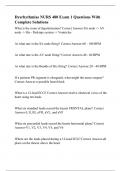
-
Dysrhythmias NURS 480 Exam 1 Questions With Complete Solutions
- Exam (elaborations) • 20 pages • 2024
-
- $13.99
- + learn more
What is the route of depolarization? Correct Answer-SA node -> AV node -> His - Purkinje system -> Ventricles At what rate is the SA node firing? Correct Answer-60 - 100 BPM At what rate is the AV node firing? Correct Answer-40 - 60 BPM At what rate is the Bundle of His firing? Correct Answer-20 - 40 BPM If a patients PR segment is elongated, what might the nurse suspect? Correct Answer-a possible heart block What is a 12-lead ECG? Correct Answer-twelve electrical views o...
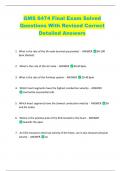
-
GMS 6474 Final Exam Solved Questions With Revised Correct Detailed Answers
- Exam (elaborations) • 41 pages • 2024
-
- $12.99
- + learn more
GMS 6474 Final Exam Solved Questions With Revised Correct Detailed Answers 1. What is the rate of the SA node (normal pacemaker) - ANSWER bpm (fastest) 2. What is the rate of the AV node - ANSWER 40-60 bpm 3. What is the rate of the Purkinje system - ANSWER 20-40 bpm 60-100 4. Which heart segments have the highest conduction velocity - ANSWER contractile myocardial cells 5. Which heart segments have the slowest conduction velocity - ANSWER and AV nodes ...
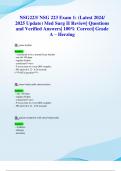
-
NSG223/ NSG 223 Exam 1: (Latest 2024/ 2025 Update) Med Surg II Review| Questions and Verified Answers| 100% Correct| Grade A – Herzing
- Exam (elaborations) • 20 pages • 2024
-
Available in package deal
-
- $10.99
- + learn more
NSG223/ NSG 223 Exam 1: (Latest 2024/ 2025 Update) Med Surg II Review| Questions and Verified Answers| 100% Correct| Grade A – Herzing Q: sinus rhythm - considered to be a normal heart rhythm - rate 60-100 bpm - regular rhythm - consistent P wave - P wave prior to every QRS complex - PR interval 0.12 - 0.20 seconds (***SATA question***) Q: sinus bradycardia characteristics Answer: - rate <60 bpm - regular rhythm - consistent P wave - P wave prior to every QRS complex...
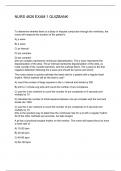
-
NURS 4626 EXAM 1 QUIZBANK
- Exam (elaborations) • 28 pages • 2024
-
- $14.99
- + learn more
To determine whether there is a delay in impulse conduction through the ventricles, the nurse will measure the duration of the patient's: A) p wave B) q wave C) pr interval D) qrs complex D) qrs complex (the qrs complex represents ventricular depolarization. The p wave represents the depolarization of the atria. The pr interval represents depolarization of the atria, av node, bundle of his, bundle branches, and the purkinje fibers. The q wave is the first negative deflection following the...
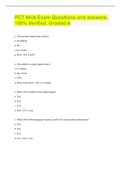
-
PCT NHA Exam Questions and answers, 100% Verified. Graded A
- Exam (elaborations) • 23 pages • 2023
-
Available in package deal
-
- $10.49
- 2x sold
- + learn more
PCT NHA Exam Questions and answers, 100% Verified. Graded A 1. The lavender-topped tube contains: a. No additive b. SPS c. Na+ citrate d. EDTA - -d. EDTA 1. The additive in a gray-topped tube is: a. K+ oxalate b. Na+ citrate c. EDTA d. None of the above - -a. K+ oxalate 1. Which of the needle has the largest gauge? a. 16 g b. 20 g c. 21 g d. 25 g - -a. 16 g 1. Which of the following gauge needle is used for the typical adult venipuncture? a. 23 g b. 16 g c. 21 g d....
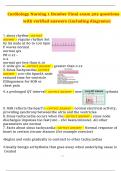
-
Cardiology Nursing 1 Humber Final exam 302 questions with verified answers (including diagrams)
- Exam (elaborations) • 37 pages • 2024
-
- $12.99
- + learn more
Cardiology Nursing 1 Humber Final exam 302 questions with verified answers (including diagrams) 1. sinus rhythm- correct answer - regular rhythm Set by SA node at 60 to 100 bpm P waves normal normal qrs PR 0.12 - 0.2 normal qrs less than 0.10
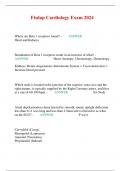
-
Fisdap Cardiology Exam 2024
- Exam (elaborations) • 17 pages • 2024
- Available in package deal
-
- $11.49
- + learn more
Fisdap Cardiology Exam 2024 Where are Beta 1 receptors found? - ANSWER Heart and Kidneys Stimulation of Beta 1 receptors result in an increase of what? - ANSWER Heart: Inotropy, Chronotropy, Dromotropy Kidneys: Renin-Angiotensin-Aldosterone System = Vasoconstriction = Increase blood pressure Which node is located at the junction of the superior vena cava and the right atrium, is typically supplied b...

$6.50 for your textbook summary multiplied by 100 fellow students... Do the math: that's a lot of money! Don't be a thief of your own wallet and start uploading yours now. Discover all about earning on Stuvia

